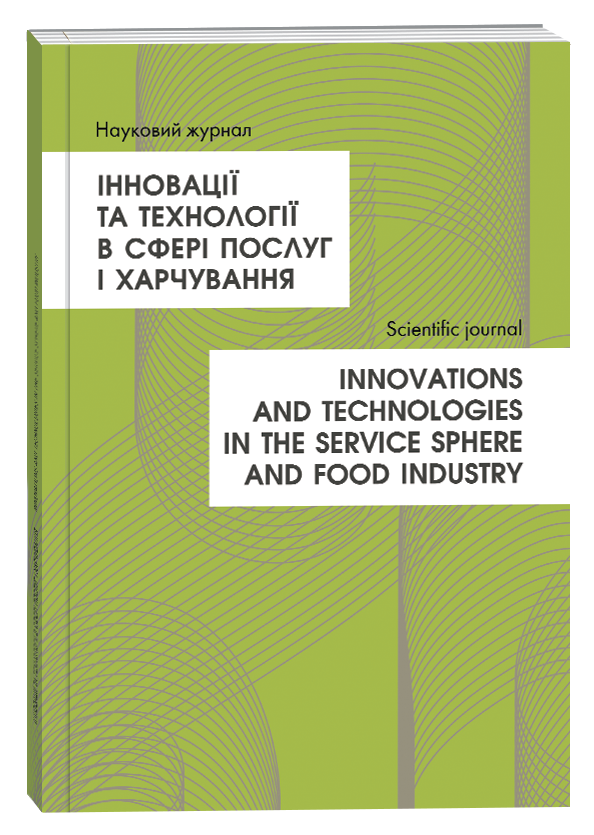ORIGINS OF THE DEVELOPMENT AND CHARACTERISTICS OF ANIMATION SERVICES IN TOURISM
Abstract
Transformations and changes in Ukraine lead to new approaches to the professional training of an education seeker. Such a direction of tourist activity as animation is actively developing all over the world as a means of competition between similar ones in terms of service level, provision of services and arrangement of interiors of hotels and tourist complexes. The concept of animation is used in many areas of human activity and requires clarification in the structure and content of the training of future specialists who will conduct animation activities. Conducting an analysis of the origins of animation activities, which have been conducted since 50 years of the last century, it was found that this type of service arose as a response to competition, because the main tasks of the animator are to create a comfortable, friendly and hospitable atmosphere in the institution, to satisfy the needs of guests in the spiritual, cultural, emotional and physical comfort, creating conditions for pleasant communication and spending leisure time. Animation is an additional service provided to guests of hotels, tourist bases, camps and other recreation and leisure facilities, together with well-organized accommodation and food, they are supposed to create the most comfortable conditions for recreation. Rationally organized animation does not leave the guest without due attention, he is constantly busy with what pleases him, evokes positive emotions, creates a wonderful mood and arouses the desire to return to such emotions again and again. In animation, active types of recreation are used, which include active sports games, swimming, running, hiking, aerobics, rock climbing, hiking, and passive ones – reading, fishing, playing music, gardening, computer games, visiting stadiums, concerts, exhibitions, museums, inspection of monuments of architecture, history and culture. From today's point of view, the problem of effective professional training of future animators capable of carrying out activities in recreation and health facilities is becoming significant and needs to be solved.
References
Балабанова Л.В. Стратегічне управління персоналом підприємства: навч. посіб. Київ : Знання, 2011. 232 с.
Готелі та інші місця для проживання Дніпропетровської області. URL: http://www.dneprstat.gov.ua/statinfo/tur/tur3.htm (дата звернення: 25.12.2023).
Данилевич М.В. Значення краєзнавчо-туристичної діяльності на етапі початкової підготовки спортсменів. Здоровий спосіб життя: матеріали ІII Міжрегіон. наук.-практ. конф. Славута. 2003. С. 6–7.
Кальченко С.В., Грибова Д.В., Демко В.С. Рекреаційні аспекти організації анамаційної діяльності в сільському туризмі. Вісник Одеського національного університету. Секція: економіка. 2019. Том 24. Випуск 4 (77). С. 94–98. URL: http://liber.onu.edu.ua/pdf/visn_econom_24_4(77).pdf
Короваєва Б., Паришкура Ю., Томіч Л. Організаційно-методичні засади у розробці сценарію свята для майбутніх фахівців фітнесу та рекреаціїї. Наукові записки Бердянського державного педагогічного університету. Серія: Педагогічні науки. 2022. Вип. 3. С. 307–313. URL: https://drive.google.com/file/d/158SgS00jxMXmS2qW88vPJRehzan1pcfW/view
Саламаха О.Є., Чеховська Г.Ю. Роль культурно-дозвіллєвої діяльності у формуванні здорового способу життя студентської молоді. Науковий часопис НПУ імені М. П. Драгоманова. 2021. Випуск 11 (142). С. 135–138.
Худоба В.В. Професійна діяльність в туристичній галузі : лекція. Львів, 2018. 15 с.
Щур Лідія, Грибовська Ірина, Іваночко Вікторія, Музика Федір. До проблеми фізкультурно-оздоровчої освіти студентів. Науковий часопис НПУ імені М. П. Драгоманова. Серія 15, Науково-педагогічні проблеми фізичної культури (фізична культура і спорт) : зб. наук. пр. Київ, 2014. Вип. 11(52)14. С. 149–153.
Bersin, J., Barnett L., Hines J. Predictions for 2017. Everything Is Becoming Digital. Deloitte Development LLC, 2016. 41 p. URL: https://www2.deloitte.com/content/dam/Deloitte/at/Documents/aboutdeloitte/predictions-for-2017-final.pdf (дата звернення: 26.12.2023).
Pavlenchyk N., Mekhovych S., Bohoslavets O., Opanashchuk Y., Hotra V., Gayvoronska I. Integration of Partial Least Squares Path Modeling for Sustainable Tourism Development. International Journal of Recent Technology and Engineering. 2019. Vol. 8, is. 2. Р. 4309–4312.
Balabanova L. V. (2011) Stratehichne upravlinnia personalom pidpryiemstva [Strategic personnel management of the enterprise]: navch. posib. Kyiv: Znannia, 232 p.
Bortnik S. M. (2014) Praktychne zastosuvannia zbalansovanoi systemy pokaznykiv yak instrumenta stratehichnoho planuvannia diialnosti pidpryiemstva [Practical application of the balanced scorecard as a tool for strategic planning of the enterprise]. Visnyk Volynskoho instytutu ekonomiky i menedzhmentu : nauk. Zhurn, vol. 1, no. 10, pp. 40–51.
Hoteli ta inshi mistsia dlia prozhyvannia Dnipropetrovskoi oblasti [Hotels and other places to stay in Dnipropetrovsk region]. Available at: http://www.dneprstat.gov.ua/statinfo/tur/tur3.htm (accessed December 25, 2023).
Danylevych M. V. (2003). Znachennia kraieznavcho-turystychnoi diialnosti na etapi pochatkovoi pidhotovky sportsmeniv [The importance of local history and tourism activities at the stage of initial training of athletes]. Zdorovyi sposib zhyttia : materialy III Mizhrehion. nauk.-prakt. konf. Slavuta. P. 6–7.
Kalchenko S. V., Gribova D. V., Demko V. S. (2019) Rekreatsiini aspekty orhanizatsii anamatsiinoi diialnosti v silskomu turyzmi [Recreational aspects of the organisation of anamation activities in rural tourism]. Bulletin of Odesa National University. Section: Economics, vol. 24, issue 4 (77), pp. 94–98. Available at: http://liber.onu.edu.ua/pdf/visn_econom_24_4(77).pdf
Korovaieva B., Paryshkura Yu., Tomich L. (2022) Orhanizatsiino-metodychni zasady u rozrobtsi stsenariiu sviata dlia maibutnikh fakhivtsiv fitnesu ta rekreatsiii [Organizational and methodological principles in the development of a holiday scenario for future fitness and recreation specialists]. Naukovi zapysky Berdianskoho derzhavnoho pedahohichnoho universytetu. Seriia: Pedahohichni nauky, vol. 3, pp. 307–313. Available at: https://drive.google.com/file/d/158SgS00jxMXmS2qW88vPJRehzan1pcfW/view
Salamakha O. Ye., Chekhovska H. Yu. (2021) Rol kulturno-dozvillievoi diialnosti u formuvanni zdorovoho sposobu zhyttia studentskoi molodi [The role of cultural and leisure activities in the formation of a healthy lifestyle of student youth]. Naukovyi chasopys NPU imeni M. P. Drahomanova, vol 11 (142), pp. 135–138.
Khudoba V. V. (2018) Profesiina diialnist v turystychnii haluzi [Professional activity in the tourism industry]: lektsiia. Lviv, 15 p.
Shchur Lidiia, Hrybovska Iryna, Ivanochko Viktoriia, Muzyka Fedir (2014) Do problemy fizkulturno-ozdorovchoi osvity studentiv [To the problem of physical culture and health education of students]. Naukovyi chasopys NPU imeni M. P. Drahomanova. Seriia 15, Naukovo-pedahohichni problemy fizychnoi kultury (fizychna kultura i sport) : zb. nauk. pr. Kyiv. Vol. 11(52)14, pp. 149–153.
Bersin J., Barnett L., Hines J. (2016) Predictions for 2017. Everything Is Becoming Digital. Deloitte Development LLC, 41 p. Available at: https://www2.deloitte.com/content/dam/Deloitte/at/Documents/aboutdeloitte/predictions-for-2017-final.pdf (accessed December 26, 2023).
Pavlenchyk N., Mekhovych S., Bohoslavets O., Opanashchuk Y., Hotra V., Gayvoronska I. (2019) Integration of Partial Least Squares Path Modeling for Sustainable Tourism Development. International Journal of Recent Technology and Engineering, vol. 8, is. 2, pp. 4309–4312.



